A vote against Modi
 N D Sharma
N D Sharma
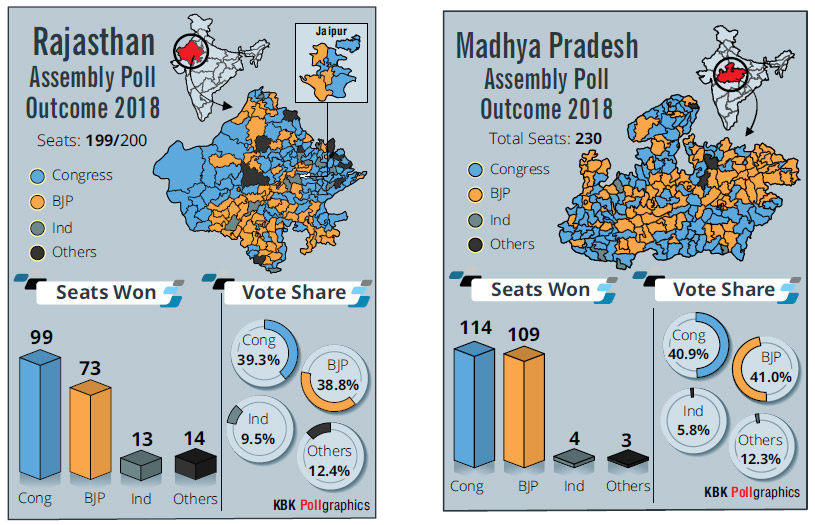
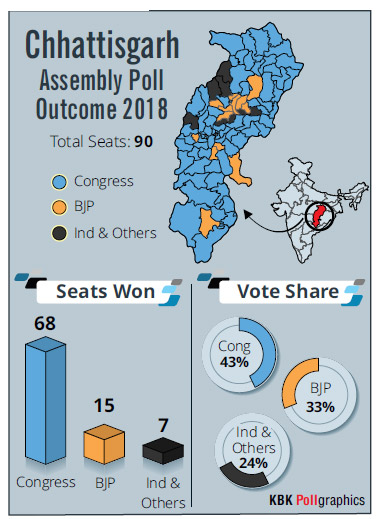 The anti-BJP drift was
visible in all the five
States where Assembly
elections were held in
November-December.
The anti-BJP drift was
visible in all the five
States where Assembly
elections were held in
November-December.
While the electorate
threw away the BJP governments in
Rajasthan, Madhya Pradesh and
Chhattisgarh, the BJP could barely
win one seat each in Telangana and
Mizoram in spite of having put
forward its candidates in almost all
the constituencies in the two States.
Even though Prime
Minister Narendra Modi’s
two major “achievements”
did not figure prominently
in the high-pitched
campaigns, these two
seemed to have
considerably influenced
the mind of the voters,
particularly in the three
Hindi heartland States of
Rajasthan, Madhya
Pradesh and Chhattisgarh.
The scars created by the
demonetisation on the
middle and lower classes
have not healed so far.
The pro and antireservation
agitations
seemed to have
considerably influenced
the voters’ choice in
Madhya Pradesh and
Rajasthan. The
organisations
representing Scheduled
Castes and Scheduled
Tribes were in a militant
mood after the Supreme
Court had diluted the
arrest provisions of the
Scheduled Castes and
Scheduled Tribes
(Prevention of Atrocities)
Act and the Central
government continued
dilly-dallying to undo it.
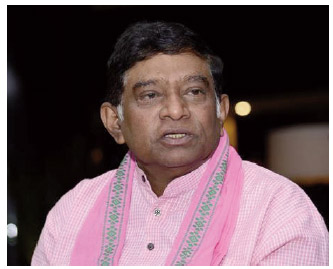 Ajit Jogi
Similarly, the GST
continues to be a sore
point with the middle rung
traders. Apparently aware
of this the party in the three
States did not seek the vote
in the name of Narendra
Modi but in the names of their chief ministers, Vasundhara Raje
in Rajasthan, Shivraj Singh Chouhan in
Madhya Pradesh and Raman Singh in
Chhattisgarh. In the full page
newspaper advertisements also, the
photos of the chief ministers were
displayed prominently while a small
photo of Narendra Modi was tucked
behind. According to an IndiaSpend
analysis of electoral data, the BJP lost
more than 70 per cent of the Assembly
constituencies where Prime Minister
Narendra Modi campaigned in the five
States.
Ajit Jogi
Similarly, the GST
continues to be a sore
point with the middle rung
traders. Apparently aware
of this the party in the three
States did not seek the vote
in the name of Narendra
Modi but in the names of their chief ministers, Vasundhara Raje
in Rajasthan, Shivraj Singh Chouhan in
Madhya Pradesh and Raman Singh in
Chhattisgarh. In the full page
newspaper advertisements also, the
photos of the chief ministers were
displayed prominently while a small
photo of Narendra Modi was tucked
behind. According to an IndiaSpend
analysis of electoral data, the BJP lost
more than 70 per cent of the Assembly
constituencies where Prime Minister
Narendra Modi campaigned in the five
States.
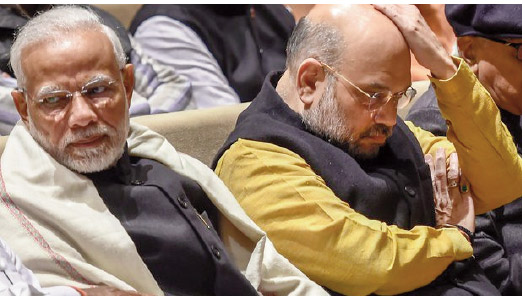 Narendra Modi and Amit Shah
Congress, though, did not appear as
the most favourite party except in
Chhattisgarh where it bagged 68 seats
in a House of 90 reducing the BJP
strength to a mere 15. In the outgoing
House the BJP had 49 members and
the Congress 39. After breaking away
from the Congress, its former Chief
Minister Ajit Jogi had formed his own
party called Janta Congress
Chhattisgarh (JCC) and had entered
into a pre-poll alliance with Mayawati’s
Narendra Modi and Amit Shah
Congress, though, did not appear as
the most favourite party except in
Chhattisgarh where it bagged 68 seats
in a House of 90 reducing the BJP
strength to a mere 15. In the outgoing
House the BJP had 49 members and
the Congress 39. After breaking away
from the Congress, its former Chief
Minister Ajit Jogi had formed his own
party called Janta Congress
Chhattisgarh (JCC) and had entered
into a pre-poll alliance with Mayawati’s
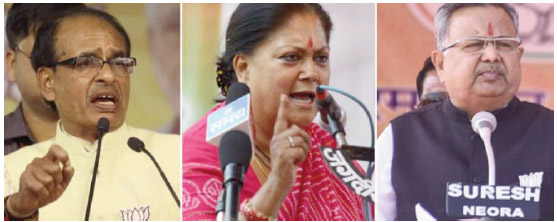 Shivraj Singh Chouhan, Vasundhara Raje and Raman Singh
Bahujan Samaj Party (BSP) in a bid to
emerge as the alternative to the BJP
and the Congress. But the electorate
decisively shattered his dream and
reposed their faith in the Congress,packing up JCC with 5 and BSP with 2
seats.
Shivraj Singh Chouhan, Vasundhara Raje and Raman Singh
Bahujan Samaj Party (BSP) in a bid to
emerge as the alternative to the BJP
and the Congress. But the electorate
decisively shattered his dream and
reposed their faith in the Congress,packing up JCC with 5 and BSP with 2
seats.
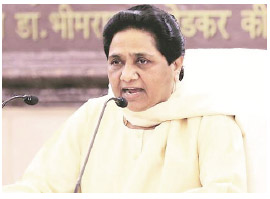 Mayawati
In Madhya Pradesh and Rajasthan,
the Congress benefited for lack of a
viable alternative to the BJP and the
Congress. The electorate, therefore,
having made up their minds to oust
the BJP government, voted for the Congress somewhat reluctantly. In
both States, the Congress failed to get
the clear majority. In Madhya Pradesh,
its tally stopped at 114 seats in a House
of 230. The BJP won in 109
constituencies. As many as 120 parties
were in the fray in Madhya Pradesh.
Only two of them could taste victory:
Bahujan Samaj Party got two seats and
Samajwadi Party was able to win one
seat. Four independents also got
through. These seven members lent
their support to the Congress, raising
the strength of the alliance to 121 and,
thus, allowing the Congress to form
the government. Aam Aadmi Party
(AAP) had fielded 208 candidates in
Madhya Pradesh. All but one lost their
deposits, including State head of AAP
and the party’s chief ministerial
candidate Alok Agrawal. AAP’s national
convener Arvind Kejriwal did not
campaign in the State even for once.
Mayawati
In Madhya Pradesh and Rajasthan,
the Congress benefited for lack of a
viable alternative to the BJP and the
Congress. The electorate, therefore,
having made up their minds to oust
the BJP government, voted for the Congress somewhat reluctantly. In
both States, the Congress failed to get
the clear majority. In Madhya Pradesh,
its tally stopped at 114 seats in a House
of 230. The BJP won in 109
constituencies. As many as 120 parties
were in the fray in Madhya Pradesh.
Only two of them could taste victory:
Bahujan Samaj Party got two seats and
Samajwadi Party was able to win one
seat. Four independents also got
through. These seven members lent
their support to the Congress, raising
the strength of the alliance to 121 and,
thus, allowing the Congress to form
the government. Aam Aadmi Party
(AAP) had fielded 208 candidates in
Madhya Pradesh. All but one lost their
deposits, including State head of AAP
and the party’s chief ministerial
candidate Alok Agrawal. AAP’s national
convener Arvind Kejriwal did not
campaign in the State even for once.
While in the three
States of Rajasthan,
Madhya Pradesh and
Chhattisgarh, the farm
distress played an
important role in
ousting the ruling BJP,
in Mizoram, the only
State in the north-east
that went to the polls,
prohibition also
played a crucial role in
replacing the Congress
with the Mizo National
Front (MNF) as the
ruling party.
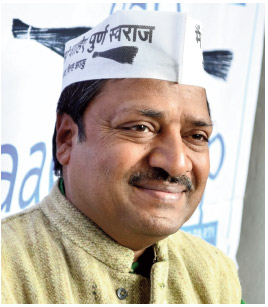 Alok Agrawal
It was ironic that the BJP received
slightly more votes in Madhya Pradesh than the Congress but the Congress
got more seats. The BJP received 41
per cent (1, 56, 42,980 votes) of the
total votes cast while the share of the
Congress was 40.9 per cent (1, 55,
95,153 votes). Besides, in as many as
22 constituencies, the votes cast for
NOTA (none of the above) exceeded
the victory margins of the winning
candidates.
Alok Agrawal
It was ironic that the BJP received
slightly more votes in Madhya Pradesh than the Congress but the Congress
got more seats. The BJP received 41
per cent (1, 56, 42,980 votes) of the
total votes cast while the share of the
Congress was 40.9 per cent (1, 55,
95,153 votes). Besides, in as many as
22 constituencies, the votes cast for
NOTA (none of the above) exceeded
the victory margins of the winning
candidates.
The pro and anti-reservation
agitations seemed to have considerably influenced the voters’
choice in Madhya Pradesh and
Rajasthan. The organisations
representing Scheduled Castes and
Scheduled Tribes were in a militant
mood after the Supreme Court had
diluted the arrest provisions of the
Scheduled Castes and Scheduled
Tribes (Prevention of Atrocities) Act
and the Central government
continued dilly-dallying to undo it.
Agitations were held in the two States,
more violent in Madhya Pradesh.
There has been
“controlled prohibition”
in Mizoram since 2014
– which means that the
people, local or
outsiders, need a
permit to buy alcohol.
There are nearly 50
authorised liquor
shops. The problem
was created by the sale
of alcohol in black
market which
developed a market of
spurious liquor
resulting in deaths. One
of the election
promises of the Mizo
National Front (MNF)
was to bring back total
prohibition if voted to
power.
When the Central government
restored the old draconian provision
through Parliament, it was the turn of
the upper castes to show their
resentment. A new organisation of
general category, OBC and minority
government employees was born
under the name of Sapaks in Madhya
Pradesh. It held demonstrations in
several parts of the State in protest
against the restoration of the stringent
provision in the Act by the Central
government.
As the elections approached,
Sapaks got itself registered as a
political party with the Election
Commission and fielded 110
candidates in the State. It did not win
even a single seat but inflicted damage
on the two main parties, more so on
the BJP. Raghunandan Sharma, a
veteran BJP leader and Rajya Sabha
member, estimates that the BJP lost 15
to 20 seats because of the anger of the
anti-reservationists.
In Rajasthan, too, the Congress
reached near-majority point, getting
99 seats in a House of 200. The
election for one constituency was
countermanded following the death of
a BSP candidate. In 2013, the Congress
had won a mere 21 seats. The BJP had
won 163 seats in the last election. This
time its tally came down to 73, a loss of
90 seats.
BSP got 6 seats, Rashtriya Lok
Tantrik Party (RLTP) 3, CPI (M) and
Bharatiya Tribal Party 2 each, and
Rashtriya Lok Dal 1. As many as 13
independents also got through. Of the
59 SC/ST seats, the BJP could get only
21 while it had won in 50
constituencies in 2013.
It got 12 seats reserved for SCs (as against 32 in 2013)
and 9 ST seats while it was successful
in 18 ST constituencies in the last
election. Rashtriya Lok Tantrik Party
(RLTP) got two seats reserved for SCs
and one was bagged by an
independent. Two ST seats went to
Bharatiya Tribal Party (BTP) and two
were won by independents. Most of
the SC/ST seats were won by the
Congress.
In 2013, the Congress could not win
a single SC seat while 32 were won by
the BJP and one each by the National
People’s Party (NPP) and National
Unionist Zamindara Party (NUZP). Of
the ST seats, the Congress had won a
mere 4 as against 18 by the BJP; two
seats were won by the NPP and one by
an independent candidate.
As the ruling BJP promised free
electricity to farmers as well as to
double farmers’ income, the Congress
promised to usher in “Kisan Raj”. Not
only in Rajasthan, but in Madhya
Pradesh and Chhattisgarh also, the
Congress promised to waive farmers’
loans within ten days of the formation
of the Congress government.
Congress
president Rahul Gandhi went to the
extent of declaring that if the Congress
government was formed and it did not
waive the farmers’ loans within ten
days, the chief minister would be
changed. This seemed to have clicked
with the farming community which
forms a substantial segment of the
electorate in the three States.
While in the three States of
Rajasthan, Madhya Pradesh and
Chhattisgarh, the farm distress played
an important role in ousting the ruling
BJP, in Mizoram, the only State in the
north-east that went to the polls,
prohibition also played a crucial role in
replacing the Congress with the Mizo
National Front (MNF) as the ruling
party.
There has been “controlled
prohibition” in Mizoram since 2014 –
which means that the people, local or
outsiders, need a permit to buy
alcohol. There are nearly 50
authorised liquor shops. The problem
was created by the sale of alcohol in
black market which developed a market of spurious liquor resulting in
deaths. One of the election promises
of the Mizo National Front (MNF) was
to bring back total prohibition if voted
to power.
One reason cited for
BJP’s failure to impress
the voters in Mizoram
was cited its failure to
keep its promise to
protect the rights of
indigenous tribes in the
north-east.
In a House of 40, the MNF got twothirds
majority with 26 seats while
Congress won only in five
constituencies. The BJP did not forge a
pre-poll alliance. BJP general secretary
in charge of north-east Ram Madhav
had announced much ahead of the
polling day: “we are willing to forge an
alliance with like-minded non-
Congress parties after the elections.”
It
had fielded 39 candidates and had
started talks with regional outfits even
before the election process was
completed, but could win only one
seat in the Chakma-dominated
constituency of Tuichawng.
Chakmas migrated from
Bangladesh over a long period ahead
of Mizoram being made a State in
1986. Young Mizo Association (YMA),
an influential tribal organisation of
Mizoram, has been demanding
scrapping of Chakma Autonomous
District Council (CADC).
Thousands of
protestors had, under the aegis of
YMA, demonstrated at Aizawl alleging
that Mizoram was increasingly
becoming a safe haven for the ‘illegal
Bangladeshi immigrants’ and are now
living, most of them, in refugee camps
in Tripura, following the trouble with
local ethnic groups of Mizoram.
(The
Election Commission enrols them as
voters of Mizoram and makes special
arrangements for their voting.) The
remaining 8 seats were won by
independent candidates.
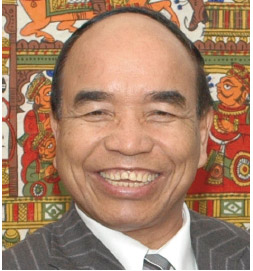 Zoramthanga
One reason cited for the BJP’s failure to impress the voters in
Mizoram was cited its failure to keep
its promise to protect the rights of
indigenous tribes in the north-east.
The north-east has for decades been
haunted by the illegal influx from the
neighbouring countries and the BJP
has had successes in the north-east
States on its pre-poll promises of
stopping this influx but it did not take
any concrete step towards fulfilling
this promise.
Zoramthanga
One reason cited for the BJP’s failure to impress the voters in
Mizoram was cited its failure to keep
its promise to protect the rights of
indigenous tribes in the north-east.
The north-east has for decades been
haunted by the illegal influx from the
neighbouring countries and the BJP
has had successes in the north-east
States on its pre-poll promises of
stopping this influx but it did not take
any concrete step towards fulfilling
this promise.
Kick-starting his party’s election
campaign, BJP president Amit Shah
declared that Mizoram would
celebrate the next Christmas under
the BJP government. Before
proceeding to Aizawl to launch the
BJP’s election campaign, Shah visited
the Kamakhya temple in Guwahati.
Then he wrote on his official Twitter
handle: “Blessed to have prayed at the Maa Kamakhya devi shaktipeeth in
Guwahati today on Durga Ashtami.:
Interestingly, the MNF is a
constituent of the BJP-led North East
Democratic Alliance (NEDA) but both
MNF and BJP contested the election
separately. MNF president
Zoramthanga, who was sworn in as
the Chief Minister for the third time,
was quoted as having observed: “Due
to Christianity and traditional ethnic
conviction, the Mizos are very closeknit
and deep-bonding society.
A party
like BJP has no space in such a society.
My government would make all-out
efforts to further develop the Mizo
society and the infrastructure of the
State, especially the roads.”




 N D Sharma
N D Sharma

 Ajit Jogi
Ajit Jogi Narendra Modi and Amit Shah
Narendra Modi and Amit Shah Shivraj Singh Chouhan, Vasundhara Raje and Raman Singh
Shivraj Singh Chouhan, Vasundhara Raje and Raman Singh Mayawati
Mayawati Alok Agrawal
Alok Agrawal Zoramthanga
Zoramthanga